Thanks to the help of commenter Thomas, we now have an excellent online source for the brick-built Cherry Garden cottage, courtesy of the American Philosophical Society Museum and the Ghost Gardens, Lost Landscapes? exhibition put together by Erin McLeary.
The cottage in Cherry Garden
This contained not only John Fanning Watson’s drawing of the cottage from about the 1820s (“courtesy of the Library Company of Philadelphia”)…
…but also its location, 39° 56′ 24.6474″ N, 75° 8′ 37.86″ W : “Now 313 S Front St, vis-a-vis Shippen St”.
Note that modern Philadelphia’s Bainbridge Street was old Philadelphia’s Shippen Street: and that Shippen Street originally stopped at Front Street. Hence the (now archaic) use of vis-a-vis, “in a position facing a specified or implied subject“, i.e. ‘on South Front Street facing Shippen Street’.
So we can see that by 1796, the Cherry Garden plot had been divided into lots and sold (as per the 1756 advertisements in the Pennsylvania Gazette I mentioned before). This was presumably broadly the same state in which John Fanning Watson saw the remains of the site.
As a sidenote, the only online record I found relating to 313 S Front St is from an 1859 letter written by a John McKay in Michigan, who gives the address (presumably) of where one of his sons (also called John McKay) is living in Philadelphia (all courtesy of the Irish Emigration Database). (Oddly, Google seems to find this page only occasionally.). The modern block numbering would be 613 South Front Street.
But before we move on, let’s briefly look a little closer at the (unannotated) 1796 map:
It seems highly likely, then, that John Fanning Watson was talking about the remains of the single house we can see on the 1796 map immediately facing Shippen Street, whose south wall (appears to have) lined up with the north wall of the house on the southwestern corner opposite it.
Google Streetview
In modern-day Philly, Bainbridge Street cuts a little across Front Street, before abruptly screeching to a halt in front of the Interstate I-95.
There are no houses of any sort East of South Front Street, just a small car park, with grassy verges on both sides:
The three houses on the west side south of the crossroads are all from the eighteenth century (all built by Nathaniel Irish), and so weren’t there in 1716 when the letter was written:
700 South Front Street – 1764 – Widow Maloby’s Tavern (on the right)
702 South Front Street – 1767 – Capt. Thomas Moore House (in the middle)
704 South Front Street – 1763-1769 – Nathaniel Irish House (on the left)
A (now long-gone) house on the same block as (old block numbering) 313 S Front St was (new block numbering) 611 South Front Street, which according to the 1909 “Publication No. 5” of the City Historical Society of Philadelphia (it says here) was “the home of early U.S. naval hero [Commodore] Stephen Decatur” (1779-1820), famed for his attacks on Barbary pirates:
Decatur was widely believed to have been the greatest, bravest President the US never quite had (he died in a duel at 41). Here’s the Philadelphia historical marker put up in his honour:
In one of those awful coincidences historians like to both notice and note, Shippen Street was renamed Bainbridge Street in honour of Commodore William Bainbridge (1774-1833), who was also Stephen Decatur’s second in his fatal duel. According to naval historian Alexander Slidell Mackenzie, Bainbridge was so jealous of Decatur’s success that he rigged the rules of the duel (only eight paces!) in order that both duellists were likely to be killed.
Anyway, now you know that here we (virtually) are on Bainbridge Street, within a few feet of where Decatur grew up.
So… Why Don’t We Just Go Dig, Then?
Slow down! I’ve only managed to cover the history of the site around the area. I’ve got lots to write up about the site itself yet (coming up next), which should help inform the whole industrial archaeology thing. Once that’s all in place, perhaps a bit of geophys would indeed be nice. 😉
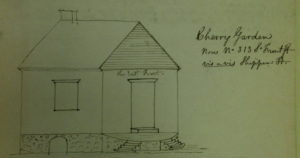
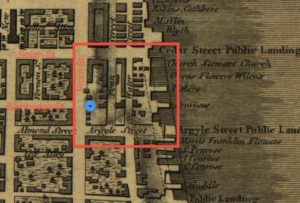
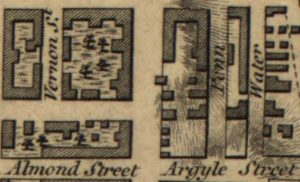
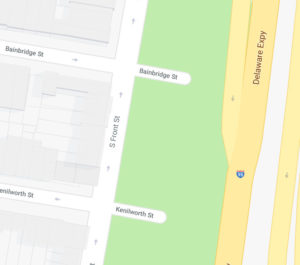

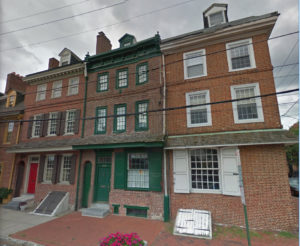
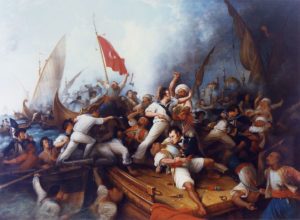
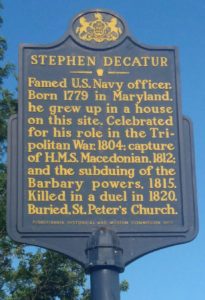
A lovely little thread you’ve put up Nick, Though there are a few elements to it that are somewhat troublesome for my old noggin. If you suggest that the ‘pretty good brick house’ of the narrative and the pretty ordinary ‘cherry garden house’ are one and the same, then perhaps I might suggest a re-think. The latter has a porch which fronts east as opposed to the former’s specifically detailed westerly outlook; whatsmore, apart from it’s obvious rough stone foundations, I can’t find sure signs of bricks anywhere. Now our unknown informant also talks of the general location of the place as being a little further south of his draubridge (sic). So if we can agree, this meant the first crossing of Dock Creek near Pine St., your ‘cherry garden house’ is in the order of five city blocks south,which seems a little further than ‘a little’, more like ‘a bridge too far’ in my estimation. These niggling little anomolies are only intended as being objective queries on fact and nothing more, so please don’t take them as being a critique on your otherwise fine piece. PS: Have you given any thought as to how our latter day treasure seeking ‘brother’ was expected to make his approach to the house, then pace out the additional 45 foot (sic) from the front porch to his dig site at the post and go about his shady business undetected. I guess the dwelling might have been vacant for some reason, though our main man should not have been expected to know all those years later, or would he?…We could have put this to Ben had we been around!..
john sanders: if history was an exact science, any fool could do it. 🙂
I accept your point about East vs West: but perhaps this will become clearer as other evidence emerges, whether geophys or otherwise.
It seems that Society Hill as we know it was not a hill at all in the strict sense, but merely a natural river embankment or bund which extended along the Delaware between Penn’s 1682 town grid and the Schuyikill river a mile or so to the south; not far from the original 1642 Swedish settlement of Wicaco. That being the case we might easily be confused with the sitings of early colonial buildings mentioned in the all too numerous historical papers we have available. It seems that substantial dwellings were in place from the 1650’s; in fact one from pre 1700 still stands right there in Sth. Front Street along with an adjacent burial ground from 1669. When Penn returned to Philadelphia years after his initial visit in 1682, he actually petitioned on behalf of a mate to have his old delapitated mansion re-built. We seem to be getting information about a town and its development many years after the period of our interest and treating it as if it were still historically applicable to a bygone period which to me seems crazy. If we are to pursue our aims regarding a letter of such dubious content and claimed authenticity, we surely must be a little more wary. We are afterall living in the era of fake news and we all know what once great society such crap eminates from.
The Cherry Garden cottage: Another drawing from Watson’s manuscript: https://libwww.freelibrary.org/digital/item/40476
There you go Thomas, a pretty good brick house indeed by all appearances and the much better sketch could well depict cherry trees nearby. Did you by any chance spot the other cherry garden up by the bridge and across Chestnut St. twixt 2nd and 3rd….” and the youth of that day long remembered the kindness of the Governors lady, who seeing their longing eyes set upon the long range of cherry trees (fronting the premises on Chestnut St.) used to invite them to help themselves from the trees”.. This came from excerpts re Carpenters mansion circa. 1730s. and there’s no doubting that such a substantial dwelling would also come within our informant’s ‘pretty good brick house’ category.
John Sanders:
Do you refer to Carpenter’s mansion on Chestnut St. between 6th and 7th St., https://archive.org/stream/earlyphiladelphi00lipp#page/30/mode/1up/search/mansion?
The only drawbridge leading southward to Society hill seemed to be the bridge on Dock creek at the southern end of Front street, https://archive.org/stream/earlyphiladelphi00lipp#page/29/mode/1up/search/drawbridge and https://books.google.de/books?id=fyQWAAAAYAAJ&pg=PA111.
Is there an online source for the other cherry garden you mentioned?
Thomas: Quite correct; in fact it was Clarke’s Hall further south along Chestnut below Third that I meant which also had extensive gardens and it overlooked Dock creek near the plank bridge. Like Carpenter’s mansion, it also housed early Govenors, including Keith who arranged to have Ben Franklin bundled off the England in 1724 I believe. Sorry about the misplaced address, cerainly worthy of censure and a caution to take more care.
With regard to Dock Creek, there is quite some conjecture regarding it’s crossing and navigation possibilities during much of the eighteenth century. John Watson reports that amongst his informants, reliable historians presumably, old folks spoke of masted schooners and other large sailing craft using the creek above Third Street in the so-called early years. Reverend Nathaniel Snowden who was born at his Grandfather’s old house in Spruce St. as late as 1770 recalls “…a beautiful stream Dock Creek flowing behind Father’s garden – grand old trees – fishing in Dock Creek &c…”. So someone’s gotta be wrong, either these good folk were mistaken or those drunken swine from the Blue Anchor bar (either one) who called Dock Creek a cess pit and swamp a early as the turn of the century were so used to throwing up in one part of it, they assumed it to be all the same. If it had have been navigable all during that time, excluding the frozen winter, beyond the 2nd and 3rd Street crossings, then we must assume that there were bridge openings means at some stage, openings similar to our letter man’s ‘few planks called a drau bridge’, which we assume to have been the one closest to the Delaware entrance near Front & Pine Streets.
Why does such a tiny place that looks more like a brick outhouse have two sets of diagonally opposed sets of stairs off the front porch (3 & 5 steps) and a weird raised slab at the doorway. I wonder could it have something to do with discouraging throngs of muddy shod of pie eaters from making a mess of the entrance perhaps?..